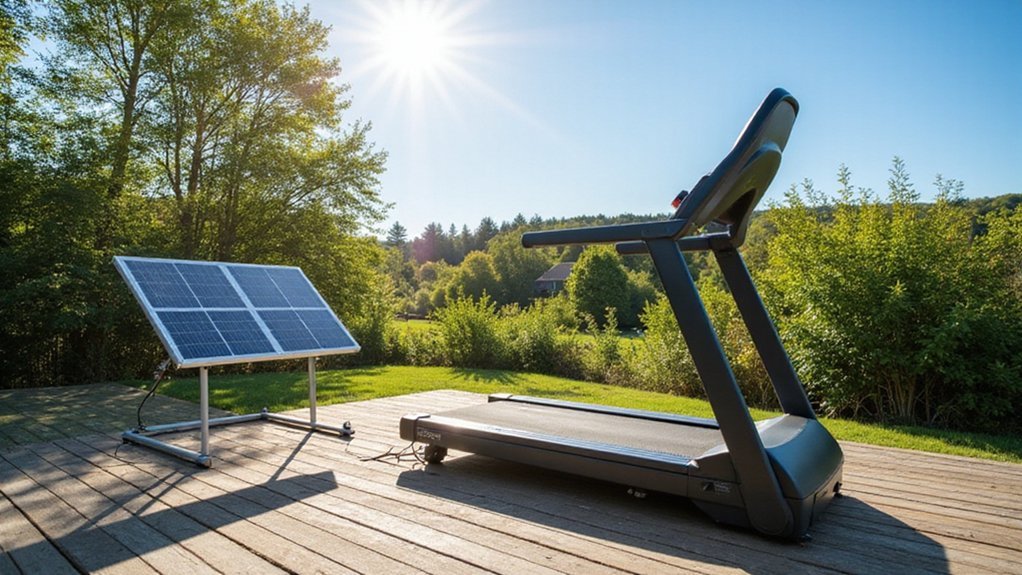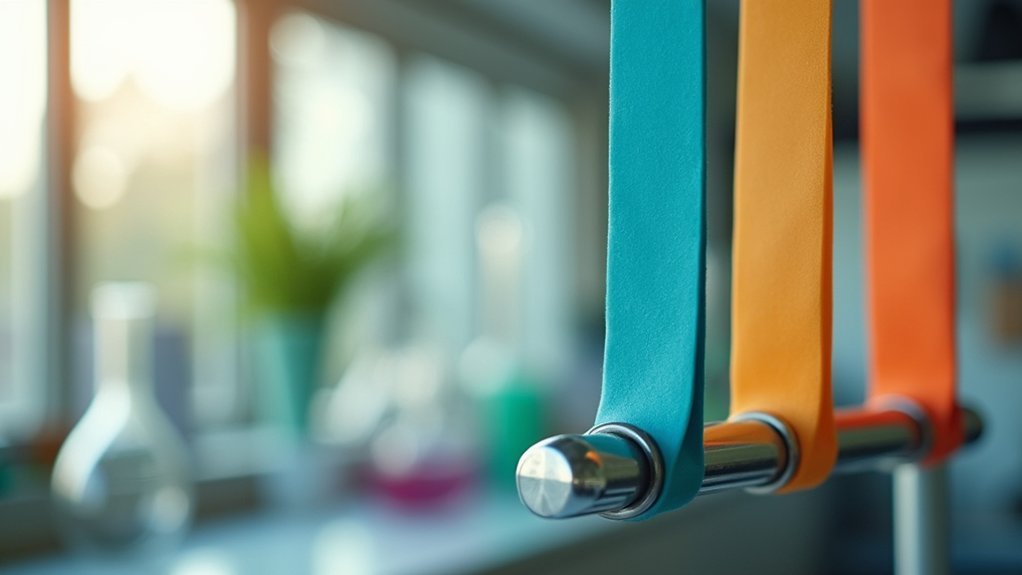Disclaimer: This content is for informational purposes only and does not replace professional medical advice, diagnosis, or treatment. Always consult a qualified healthcare provider before beginning any new exercise program.
You’ll quickly discover that traditional cable machine attachments often fall short for users with prosthetic limbs. Standard equipment lacks the adaptive flexibility required for seamless, comfortable workouts. But what if you could transform your strength training experience with precision-engineered attachments designed specifically for prosthetic users? Innovative solutions are emerging that promise to bridge the gap between adaptive needs and high-performance fitness equipment. Are you ready to explore how these game-changing attachments could revolutionize your training approach?
Key Takeaways
- Adaptive cable machine attachments with adjustable straps and ergonomic handles enable secure and comfortable workouts for prosthetic users across different limb configurations.
- High-strength steel and chrome-plated materials in specialized attachments provide durability, stability, and enhanced grip for individuals with prosthetic limbs.
- Multi-grip design attachments like lanyard kits and stirrups allow targeted muscle isolation and personalized exercise experiences for users with varying prosthetic needs.
- Quick-connect mechanisms and tool-free adjustments facilitate seamless equipment transitions and accommodate individual biomechanical differences during strength training.
- Consultation with certified prosthetists ensures proper equipment selection, minimizing injury risks and maximizing functional strength development for prosthetic users.
Understanding the Challenges of Cable Machine Workouts for Prosthetic Users

While cable machine workouts offer extensive strength training benefits, prosthetic users often encounter unique biomechanical challenges that can compromise exercise effectiveness and safety. Gripping handles and maintaining balance become complex issues, potentially leading to asymmetrical movements that increase injury risk. Conventional cable machine attachments frequently fail to accommodate the diverse needs of prosthetic users, creating barriers to thorough strength training.
Ergonomic solutions require collaborative approaches with certified prosthetists to develop personalized workout plans. By focusing on secure grip techniques and specialized attachments, prosthetic users can optimize their cable machine experience. Tailored modifications enable more stable and controlled movements, transforming potential limitations into opportunities for adaptive strength training that respects individual biomechanical differences.
Essential Features of Prosthetic-Compatible Cable Attachments

Five key considerations define the essential features of prosthetic-compatible cable attachments, altering standard exercise equipment into adaptive fitness solutions. You’ll need adjustable straps and high-strength materials to guarantee secure handling and durability for prosthetic users. Ergonomically designed handles with multi-grip options provide versatility and comfort, allowing you to isolate specific muscle groups effectively.
| Feature | Benefit | Mechanism |
|---|---|---|
| Adjustable Straps | Custom Fit | Accommodates limb variations |
| Knurled Handles | Stability | Reduces slippage risk |
| Quick Connect Snaps | Exercise Alterations | Enables rapid equipment changes |
Chrome-plated steel attachments with quick connect snaps maximize your workout potential. These prosthetic-compatible design elements create an inclusive fitness experience, guaranteeing you can confidently engage in strength training with enhanced comfort and stability.
Top Cable Machine Attachment Solutions for Various Prosthetic Configurations

Since prosthetic users require specialized equipment for effective strength training, cable machine attachments must offer versatile, adaptive solutions across different limb configurations. Durable cable machine attachments constructed from solid steel and chrome provide secure gripping options that accommodate diverse prosthetic needs. The Lanyard V3 Kit stands out, offering tool-free adjustments for upper and lower extremity prosthetics, ensuring ergonomic use and workout safety.
Adjustable handles and straps become critical in personalizing equipment for individual limb differences. By consulting certified prosthetists, you’ll identify cable machine attachments precisely matched to your specific prosthetic configuration. These specialized attachments—like multi-grip stirrups and tricep pressdown bars—enable targeted muscle isolation, transforming potential limitations into strength training opportunities.
Safety and Ergonomics in Adaptive Gym Equipment Design

Because prosthetic users demand uncompromising safety in strength training equipment, adaptive cable machines must integrate sophisticated ergonomic design principles that mitigate potential risks and optimize user performance.
- Safety hinges on secure attachment systems utilizing high-strength materials like solid steel and durable polymers, which withstand intense lifting stresses while providing reliable prosthetic user support
- Ergonomic design incorporates adjustable components that accommodate diverse body types, enabling personalized configurations that enhance comfort and stability during workouts
- Interface optimization focuses on minimizing pressure points and facilitating a natural range of motion, ensuring prosthetic users can execute exercises with confidence and reduced strain
Adaptive equipment’s success depends on meticulously engineered solutions that prioritize individual user needs, transforming potential limitations into opportunities for thorough strength training experiences.
Real-World User Experiences and Success Stories

The engineering principles of prosthetic-friendly cable machines find their truest validation through real-world user narratives that illuminate functional adaptability. Individuals like Angel demonstrate how specialized terminal devices and custom-built accessories transform weightlifting regimens, enabling thorough strength training despite limb differences. Wendi’s successful utilization of the Multi D device proves that tailored cable attachments can support loads up to 40 pounds safely, expanding prosthetic technology’s functional boundaries.
Community support plays a critical role in sharing adaptive strategies, with users like Claudia highlighting how custom hardware contributes to mental well-being and physical confidence. These real-world experiences validate the importance of ergonomic design, showcasing how innovative prosthetic accessories can create balanced weightlifting experiences that empower individuals with limb variations.
Selecting the Right Cable Machine Attachments for Your Fitness Goals
How do you transform a standard cable machine into a personalized fitness ecosystem? By strategically selecting cable machine attachments that align with your specific fitness goals and physiological needs. Consider these key selection criteria:
- Prioritize material durability with solid steel and chrome-plated attachments that withstand high-intensity training
- Match connector sizes precisely to guarantee compatibility and maximize workout efficiency
- Choose versatile attachments that enhance core stability and functional strength
Your attachment selection directly impacts workout variety and targeted muscle engagement. Multi-grip bars and stirrup handles can dramatically expand exercise possibilities, allowing you to customize your training approach. By focusing on ergonomic design and technical compatibility, you’ll create a cable machine setup that adapts to your unique fitness journey, whether you’re a beginner or an advanced athlete seeking specialized strength development.
Frequently Asked Questions
Can You Work Out With a Bionic Arm?
You’ll adapt your bionic arm’s functionality through specialized training techniques, leveraging mobility assistance devices and customized fitness plans that enable strength training, overcome sports participation challenges, and track recovery progress.
How Do Prosthetics Stay Attached?
Securely synced solutions grip your limb: adjustable straps, magnetic connections, and locking mechanisms guarantee prosthetic stability. Custom adaptations and silicone sleeves provide seamless attachment, maximizing user comfort and movement fluidity through precise, ergonomic design.
Can People With Prosthetic Arms Lift Weights?
You’ll definitely lift weights with adaptive equipment designed for prosthetic arms. By mastering specific weightlifting techniques and working with specialized personal trainers, you’ll engage muscles effectively, achieving strength training goals through tailored resistance exercises.
What Is the Difference Between Prosthetic and Prosthesis?
You’ll hilariously discover “prosthetic” describes the broader field, while “prosthesis” specifics the actual device. It’s like calling engineering versus the engineered product—one’s the process, the other’s the precise technological adaptation replacing missing body functionality.
Conclusion
Powerful prosthetic performance peaks with precise, purposeful cable machine attachments. You’ll discover transformative fitness solutions that seamlessly integrate adaptive design with personal strength goals. By selecting specialized equipment tailored to your unique biomechanical needs, you’ll optimize workout effectiveness, enhance muscle engagement, and push beyond perceived limitations. Embrace innovative attachments that turn challenges into opportunities for dynamic, personalized strength training.



